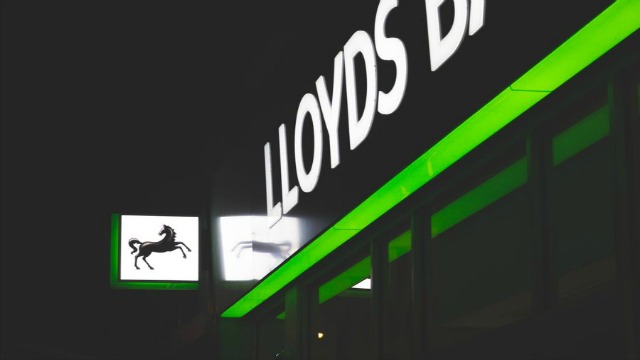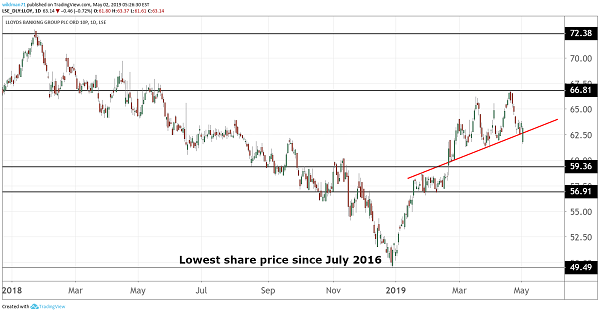Lloyds Banking Group: Q1 results analysis
After a stunning share price performance, do these 'hit and miss' results justify optimism?
2nd May 2019 12:19
by Graeme Evans from interactive investor
After a stunning share price performance, do these 'hit and miss' results justify optimism?

Lloyds Banking Group (LSE:LLOY) investors, in need of a silver lining after an underwhelming earnings season from UK lenders, only have to look back 24 hours to the surprise gift handed to the bank by regulators yesterday.
Analysts think the decision by the Prudential Regulation Authority (PRA) allowing Lloyds to reduce its risk buffer has the potential to increase the capacity for share buy-backs by £1 billion in 2019. Investec Securities' Ian Gordon called it "just the tonic" ahead of today's first-quarter results.
As it turned out, the news helped to soften the blow of today's figures as Lloyds mirrored the disappointing top-line performances already seen by Barclays (LSE:BARC) and The Royal Bank of Scotland Group (LSE:RBS).
Adjusted revenues were 4% below market consensus at £4.4 billion, while unchanged pre-tax profits of £1.6 billion also came in slightly below hopes. Remarkably, the seemingly never-ending payment protection insurance (PPI) compensation story continues to hang over Lloyds' numbers after the bank set aside another £100 million in today's results.
The softer income performance has been seen across the UK banking sector at the start of 2019, contributing to the slow pace in the recovery of Lloyds shares from the 50p low in December.
Fierce competition and low interest rates continue to put pressure on margins in the mortgage market while Brexit uncertainty is hampering business investment. Lloyds appears to be weathering the storm, however, after today's net interest margin fell just one basis point on the previous quarter to 2.91%. Last Friday, RBS said its margin fell to 1.89% from 1.95%.
There was also praise for the bank's performance on driving down operating expenses after its cost:income ratio showed further improvement at 44.7%. Credit quality is also strong, with the impairment provision of £275 million only slightly higher than the previous quarter.
While chief executive António Horta-Osório remains alert to the economic impact of Brexit, he offered a measure of reassurance today by sticking to the group's targets for 2019. These include maintaining the net interest margin at 2.9% and delivering operating costs of below £8 billion as Lloyds seeks a cost:income ratio in the low 40s by next year.
Lloyds is also eyeing a return on equity figure of between 14% and 15% in 2019, compared with 12.5% in the current quarter. The tight control of the business has already enabled a share buyback of £1.75 billion, alongside a dividend yield of above 5%.

Source: TradingView Past performance is not a guide to future performance
Yesterday's announcement from the PRA on the systemic risk buffer requirement for UK's ring-fenced banks should give Lloyds more room to move in terms of future shareholder returns.
Lloyds now thinks the current level of capital required to grow the business as well as meet regulatory requirements and cover uncertainties has reduced from around 13% to 12.5%, plus a management buffer of around 1%.
It pointed out it had a "progressive and sustainable ordinary dividend policy" and that it would continue to give consideration to the distribution of surplus capital at the end of the year.
UBS analyst Jason Napier thinks the PRA news has increased the 2019 pay-out capacity by £1 billion or 2.5% of market cap. When added to Lloyds' own capital generation target, this amounts to the potential for total pay-outs of 10% of market cap for 2019.
He continues to have a price target of 80p on Lloyds, while also backing Barclays and RBS as his other 'buy' recommendations in UK banking. Napier, who values Lloyds at 7.1 times 2020 earnings, said:
"We think the stock is good value in absolute and relative terms despite the lower Q1 print."
These articles are provided for information purposes only. Occasionally, an opinion about whether to buy or sell a specific investment may be provided by third parties. The content is not intended to be a personal recommendation to buy or sell any financial instrument or product, or to adopt any investment strategy as it is not provided based on an assessment of your investing knowledge and experience, your financial situation or your investment objectives. The value of your investments, and the income derived from them, may go down as well as up. You may not get back all the money that you invest. The investments referred to in this article may not be suitable for all investors, and if in doubt, an investor should seek advice from a qualified investment adviser.
Full performance can be found on the company or index summary page on the interactive investor website. Simply click on the company's or index name highlighted in the article.